

LEARN ONE THING
EVERY DAY
JUNE 1 1916
SERIAL NO. 108
THE
MENTOR
SHAKESPEARE’S
COUNTRY
By WILLIAM WINTER
Poet and Critic
DEPARTMENT OF
TRAVEL
VOLUME 4
NUMBER 8
FIFTEEN CENTS A COPY

It is the everlasting glory of Stratford-upon-Avon that it was the birthplace of Shakespeare. Situated in the heart of beautiful Warwickshire, it nestles cosily in an atmosphere of tranquil loveliness, and it is surrounded by everything that gentle rural scenery can provide to soothe the mind and to nurture contentment. It stands upon a plain, almost in the center of England, through which, between low green hills that roll away on either side, the Avon flows, in many capricious windings, to the Severn, and so to the sea.
The golden glory of the setting sun burns on the gray spire of Stratford church, and on the ancient graveyard below,—wherein the mossy stones lean this way and that, in sweet and orderly confusion,—and on the peaceful avenue of limes, and on the burnished water of silver Avon. The tall, pointed, many-colored windows of the church glint in the evening light. A cool, fragrant wind is stirring the branches and the grass. The songbirds, calling to their mates or sporting in the wanton pleasure of their airy life, are circling over the church roof or hiding in little crevices of its walls. On the vacant meadows across the river stretch away the long, level shadows of the stately elms.
It is an accepted tradition in Stratford-upon-Avon that the bell of the Guild Chapel was tolled on the occasion of the death and also of the funeral of Shakespeare.
From “Shakespeare’s England,” by William Winter

WARWICK CASTLE, WARWICK
Shakespeare’s Country
Monograph Number One in The Mentor Reading Course

No one should come abruptly upon Stratford, the home of Shakespeare, as Mr. Winter says. It is wiser and pleasanter to approach it gradually by way of Warwick and Kenilworth. Both these castles have a place in Shakespeare’s plays, and it is well worth while for the visitor to see them.
Warwick is a quaint old town. Its population is about 12,000, and it lies on a hill rising from the river Avon. Far back in antiquity it was a settlement of the Britons, and, afterward, it was occupied by the Romans. Its present name is of Saxon origin. Many of the houses retain their medieval appearance; and in fact two of the old gates of the town are still standing.
The prevailing quality of the town of Warwick is a sweet, solemn peace. The people live there as in a gentle dream of repose. The little rows of cottages breathe contentment; ivy embowers them, and roses cluster about their windows.
The Church of St. Mary at Warwick as it now stands was rebuilt after a fire in 1694. The Lord Leicester Hospital was established by Robert Dudley, Earl of Leicester, in 1571. He founded it for the reception of twelve poor men. This building contains several interesting relics, one of which is a Saxon chair said to be a thousand years old; and another is a piece of needle-work by Amy Robsart, the heroine of Sir Walter Scott’s novel, “Kenilworth.”
On a commanding position overlooking the Avon rises Warwick Castle, the ancient and stately home of the Earls of Warwick. This castle is one of the finest and most picturesque feudal residences in England. It probably dates from Saxon times; but the oldest part now standing is the tall Cæsar’s Tower, 147 feet high, which was probably built soon after the Norman conquest. In 1871 a great fire almost completely destroyed the castle; but it was restored in the old style. The most important event in the history of the building was its successful defence by the Parliamentarians during the Civil War in England.
The interior of the castle contains an interesting collection of paintings, old armor, and other curiosities. In the Great Hall are the sword and some other relics of the legendary Count Guy of Warwick. His feats of arms in slaying terrible monsters are an important part of English legend. In the Great Hall also are the mace of Richard Neville, Earl of Warwick, who was known as “the king maker,” and the helmet of Oliver Cromwell. This castle is noted for its famous collection of pictures, among which are several by Rubens and Van Dyck. In the conservatory of the castle is preserved the famous Warwick vase of marble, which was found near Hadrian’s Villa at Tivoli, in Italy, and is attributed to the fourth century B. C.
Nathaniel Hawthorne has put into words the very feeling that comes over each visitor to Warwick: “We can scarcely think the scene real, so completely do those towers, the long line of battlements, the massive buttresses, the high-windowed walls, shape out our indistinct ideas of the antique time.”
PREPARED BY THE EDITORIAL STAFF OF THE MENTOR ASSOCIATION
ILLUSTRATION FOR THE MENTOR, VOL. 4, No. 8, SERIAL No. 108
COPYRIGHT, 1916, BY THE MENTOR ASSOCIATION, INC.

KENILWORTH CASTLE, KENILWORTH
Shakespeare’s Country
Monograph Number Two in The Mentor Reading Course

It was in 1575 at Kenilworth Castle that the Earl of Leicester, then a suitor for the hand of Queen Elizabeth, entertained her and the court at “excessive cost” as described in “Kenilworth,” by Sir Walter Scott.
Everyone who has read the book knows that the Earl of Leicester had secretly married Amy Robsart, the daughter of a country gentleman, and at the same time was attempting to gain the favor of Elizabeth. When a disclosure of the truth was about to precipitate the ruin of Leicester, he prepared a magnificent pageant at his castle for the Queen; in the meanwhile his follower, Varney, was to pass himself off as Amy’s husband.
At Kenilworth Castle, on the Queen’s first entry, “a small floating island illuminated by a great variety of torches … made its appearance upon the lake,” upon which, clad in silks, were the Lady of the Lake and two nymphs waiting on her. During the several days of the Queen’s stay “rare shews and sports were exercised.”
The town of Kenilworth has a population of only about 5,000. The magnificent old castle is now in ruins. It was originally founded about 1120. In the 13th century it passed into the hands of Simon de Montfort. Some years later it came to John of Gaunt. Later the castle became royal property, and in 1562 Queen Elizabeth presented it to the Earl of Leicester. He spent enormous sums of money in enlarging and improving the building. At his death, however, it passed back into the possession of the Crown. When Cromwell became Ruler of England he gave the castle to some of his officers, who demolished the stately pile for the sake of its materials. After the Restoration it passed into the hands of the Earl of Clarendon, who still retains it. One of the principal parts of the building remaining is Leicester’s gatehouse, now occupied as a private dwelling. Then there is also the Norman Keep of Cæsar’s Tower. This has massive walls fifteen or sixteen feet thick. Merwyn’s Tower, built by John of Gaunt about 1392, may also be seen: the “small octangular chamber” on its second floor is the one assigned by Walter Scott to Amy Robsart.
PREPARED BY THE EDITORIAL STAFF OF THE MENTOR ASSOCIATION
ILLUSTRATION FOR THE MENTOR, VOL. 4, No. 8, SERIAL No. 108
COPYRIGHT, 1916, BY THE MENTOR ASSOCIATION, INC.

CHARLECOTE, STRATFORD-UPON-AVON
Shakespeare’s Country
Monograph Number Three in The Mentor Reading Course

The well-known tale of Shakespeare’s poaching on the preserves of Sir Thomas Lucy and his subsequent punishment is doubted by many authorities; yet this story has clung to the poet and has always been associated with the house of Charlecote.
The legend runs that Shakespeare as a gay and heedless youth stole deer from the park at Charlecote. The fact of the matter is that there were no deer at Charlecote at the time; but there was a warren, and this term legally covers a preserve for other animals than hares or rabbits. At any rate, the young poet is said to have been called up before Sir Thomas Lucy, who was then sheriff, and prosecuted in 1585. There is added the statement that Shakespeare aggravated the offence by writing a silly ballad on Sir Thomas and affixing it to his gate. This gave the Knight great offence, and Shakespeare is said to have been driven from Stratford to London. The ballad, however, is probably a forgery.
Shakespeare is generally supposed to have caricatured Sir Thomas Lucy in his portrait of Justice Shallow in the second part of “Henry IV,” and in the “Merry Wives of Windsor.” This may be true for, in the coat-of-arms of Lucy there were three “luces”; while Slender remarks of Robert Shallow that “the ancestors who come after him may give the dozen white luces in their coat.”
Sir Thomas Lucy was born on April 24, 1532. Three of his ancestors had been sheriffs of Warwickshire and Leicestershire: and on his father’s death in 1552 Thomas inherited the estates of Sherborne and Hampton Lucy, in addition to Charlecote, which was rebuilt for him by John of Padua in about 1558. In 1565 he was knighted and a few years later he became high sheriff of the county.
In 1558 Sir Thomas Lucy introduced into Parliament a bill for the better preservation of game and grain; this, together with his reputation as a preserver of game, gives some color to the Shakespearian tradition connected with his name. He died at Charlecote on July 7, 1600. The Charlecote estates eventually passed to the Rev. John Hammond through his marriage with Alice Lucy, and in 1789 he himself adopted the name of Lucy.
Charlecote is still occupied by one of his descendants. It contains a good collection of old paintings, antique furniture, and many objects of Shakespearian interest. The park is now well stocked with deer.
Charlecote Church, nearby, contains several monuments of the Lucy family, including one to the wife of Sir Thomas Lucy with a fine epitaph written by the Knight himself. This epitaph shows that Sheriff Lucy could hardly have been otherwise than kind and gentle. He may have been a severe magistrate and perhaps a haughty, disagreeable neighbor, but in those lines there is a tone of manhood and high feeling that wins a prompt response of sympathy. If Shakespeare stole the deer of Sir Thomas Lucy, he received just punishment and the Knight was not to blame.
PREPARED BY THE EDITORIAL STAFF OF THE MENTOR ASSOCIATION
ILLUSTRATION FOR THE MENTOR, VOL. 4, No. 8, SERIAL No. 108
COPYRIGHT, 1916, BY THE MENTOR ASSOCIATION, INC.

THE CHURCH AND THE RIVER, STRATFORD-UPON-AVON
Shakespeare’s Country
Monograph Number Four In The Mentor Reading Course
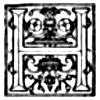
Historians may deny it, statisticians may disprove it, yet Stratford is the heart of England, and the little Avon is in a sense the most famous of all English rivers. It is the goal of all Shakespeare lovers. The poet and the river are Stratford’s two claims for distinction—but what place could ask for more? The Avon gives it a setting, the beauty of which can never entirely pass from the mind of the beholder; Shakespeare, the man and the poet, is to be seen and heard everywhere.
Stratford-upon-Avon is a clean and well built little country town of about 8,000 or 9,000 inhabitants. It has wide and pleasant streets with numerous quaint half-timbered houses. It is a place of great antiquity. Stratford is mentioned in a Saxon Charter of the eighth century, and Roman coins have been found in the district showing that it was inhabited in Roman times. Later it had some importance as an agricultural center. In addition to this, the various trades of weaving, glove-making, candle-making, and soap-making were carried on; but now these have lost their importance, and the town owes its fame almost entirely to the memory of Shakespeare, born there in 1564. Over 35,000 pilgrims annually visit Stratford.
The River Avon, gently flowing among meadows and forests, is navigable only for small boats. At Stratford it is crossed by a stone bridge of fourteen arches. This was built by Sir Hugh Clopton in the reign of Henry VII.
On the bank of the river is the Church of the Holy Trinity. It occupies the site of a Saxon monastery, and was probably completed in the fifteenth century. It was greatly restored in 1890-1892 and 1898. The central tower dates probably from the twelfth century. This is surmounted by a lofty spire.
The interior of the church contains many things of interest, but those that attract the visitor most strongly are, of course, the ones connected with Shakespeare. There is his grave, and there on the wall above is the bust which was executed soon after his death. The stained glass window nearby, representing the Seven Ages, was erected with the contributions of American visitors. Near Shakespeare’s tomb are those of his wife, Anne Hathaway, of his daughter and son-in-law, and of Thomas Nash, the first husband of his granddaughter, Elizabeth.
Shakespeare’s House, in which the poet was born in 1564, is now national property.
The Shakespeare Memorial Building, the site for which was presented to the town of Stratford by Charles Edward Flower, stands on the banks of the Avon a little above Trinity Church. It was erected in 1879. It includes a Theater in which annual performances are held in April, and occasional performances during the winter. The “Droeshout Portrait” of Shakespeare, an authentic portrait of the dramatist, is one of the treasures kept in this building. In the adjoining grounds is the Shakespeare Monument presented in 1888 by the sculptor Lord Ronald Gower. On top of the Monument is a large seated figure of the poet, and around the base are figures of Lady Macbeth, Prince Hal, Falstaff, and Hamlet.
The Red Horse Hotel in Stratford contains a bedroom and a sitting-room occupied by Washington Irving. There may still be seen the chair in which he sat and the poker with which he meditatively stirred the fire.
PREPARED BY THE EDITORIAL STAFF OF THE MENTOR ASSOCIATION
ILLUSTRATION FOR THE MENTOR, VOL. 4, No. 8, SERIAL No. 108
COPYRIGHT, 1916, BY THE MENTOR ASSOCIATION, INC.

THE GUILD CHAPEL AND THE SITE OF NEW PLACE, STRATFORD-UPON-AVON
Shakespeare’s Country
Monograph Number Five in The Mentor Reading Course

The earliest record of the house in which Shakespeare died at Stratford is contained in these words of a visitor there in 1760:
“There stood here till lately the house in which Shakespeare lived, and a mulberry-tree of his planting; the house was large, strong and handsome; the tree so large that it would shade the grass-plot in your garden, which I think is more than twenty yards square, and supply the whole town with mulberries every year. As the curiosity of this house and tree brought much fame, and more company and profit, to the town, a certain man, on some disgust, has pulled the house down, so as not to leave one stone upon another, and cut the tree, and piled it as a stack of firewood, to the great vexation, loss, and disappointment of the inhabitants; however, an honest silversmith bought the whole stack of wood, and makes many odd things of this wood for the curious, some of which I hope to bring with me to town.”
The “certain man” who pulled the house down was the Reverend Francis Gastrell. Shakespeare bought New Place in 1597. It had been built by Sir Hugh Clopton in 1483. After Shakespeare went to live in it we can imagine him standing in his garden and watching the boys with their “shining morning faces” going to the school nearby. Now, however, nothing remains but the foundation of the house.
Shakespeare died there on April 23, 1616. He left the house to his daughter, Susan Hall. She lived there until 1649, and her daughter in turn kept it until 1670. In 1753 it came into the possession of the Reverend Francis Gastrell. Visitors annoyed him so much that he cut down the poet’s mulberry-tree that grew in the garden, and later razed the house to the ground. The site was purchased by money raised through public subscription and presented to the trustees of Shakespeare’s birthplace in 1870. Only the foundations are now visible, covered over by wire. The great garden at the back is now a public garden, and in it on the central lawn is a mulberry-tree, descended from the poet’s own tree.
Next to New Place is the house of Shakespeare’s grandson by marriage, Thomas Nash. It has been restored so as to give it the appearance it had in Shakespeare’s day. Thomas Nash was married to Elizabeth Hall, Shakespeare’s only granddaughter and last surviving descendant.
Opposite New Place stands the Guild Chapel. This is externally much the same as in the poet’s day. It is adjoined by the old Guild Hall, where Shakespeare may often have seen the performances of strolling players. The upper story is the Grammar School in which he was educated.
PREPARED BY THE EDITORIAL STAFF OF THE MENTOR ASSOCIATION
ILLUSTRATION FOR THE MENTOR, VOL. 4, No. 8, SERIAL No. 108
COPYRIGHT, 1916, BY THE MENTOR ASSOCIATION, INC.

THE VILLAGE OF SHOTTERY—WHERE ANNE HATHAWAY LIVED
Shakespeare’s Country
Monograph Number Six in The Mentor Reading Course

Tradition has always fixed the house known as Anne Hathaway’s Cottage in Shottery as the house where Shakespeare wooed and won his bride. There is no doubt that the house belonged to a family named Hathaway, but whether to those from whom Anne sprang cannot be said with certainty.
The village of Shottery is about one mile from Stratford. It is a prosperous little town with one or two industries and many substantial cottages. Anne Hathaway’s Cottage stands on the outskirts. It is a rather large building of the Elizabethan period and was once a farmhouse. It stands today practically as it was in Shakespeare’s time. In front of the cottage is a small garden gay with old-fashioned flowers.
The house itself is built of wood and plaster and covered with a thatched roof. The interior is low-ceilinged; and the main room has a stone floor and wide fireplace with cozy chimney corner. The house contains an old wooden settle on which Shakespeare may often have sat, a carved bedstead, and other relics of three hundred years ago.
A bedroom which is said to have been that of Anne Hathaway, has a sloping roof and contains some old pottery, chairs, and tables.
Anne Hathaway’s Cottage was purchased for the British nation in 1892 at a cost of about $15,000. It is now cared for by the “Shakespeare Birthplace Trust.”
The Hathaways had lived in Shottery for forty years prior to Shakespeare’s marriage. At this time the poet was just eighteen, while Anne herself was nearly twenty-six. They were married in November, 1582.
It is not known exactly where Shakespeare and his wife lived during the first years after their marriage. However, in 1585 he was obliged to leave his wife and children and go to London to seek his fortune. It is probable that Anne then returned beneath her parents’ roof. No one can look upon this humble cottage without a thrill as he realizes that the garret of the cottage in Shottery may often have welcomed the poet when he came home from his labors in the great city.
PREPARED BY THE EDITORIAL STAFF OF THE MENTOR ASSOCIATION
ILLUSTRATION FOR THE MENTOR, VOL. 4, No. 8, SERIAL No. 108
COPYRIGHT, 1916, BY THE MENTOR ASSOCIATION, INC.
By WILLIAM WINTER
Poet and Critic

Warwick Castle
Cæsar’s Tower from the Lawn
THE MENTOR · DEPARTMENT OF TRAVEL · JUNE 1, 1916
MENTOR GRAVURES—WARWICK CASTLE · KENILWORTH CASTLE · CHARLECOTE · THE CHURCH AND THE RIVER, STRATFORD · THE SOUTH CHAPEL AND THE SITE OF NEW PLACE, STRATFORD · THE VILLAGE OF SHOTTERY
Entered at the Post-office at New York, N. Y., as second-class matter. Copyright, 1916, by The Mentor Association, Inc.
The Shakespeare[1] Country, Warwickshire, is situated nearly in the center of England, and the birthplace of Shakespeare, Stratford-upon-Avon, is situated in the southern part of Warwickshire. A pleasant way in which to enter the Shakespeare Country is to travel by rail from London to Warwick, and then drive from Warwick to Stratford. There are two roads for the drive, one twelve miles long, the other eight. Both are agreeable; but the longer is the better, because more can be seen by the way. The traveler is wise who lodges for a few days at Warwick, in order to visit Warwick Castle, St. Mary’s Church, the ancient Gates, and the hospital for twelve aged men founded in 1571 by Queen Elizabeth’s favorite, Robert Dudley, Earl of Leicester (the scene of Hawthorne’s singular posthumous romance, “Dr. Grimshawe’s Secret”), and incidentally to make excursions northward to Kenilworth and Coventry.
[1] There are 4,000 variations in the spelling of the name “Shakespeare.” An entire book has been made up on the subject.
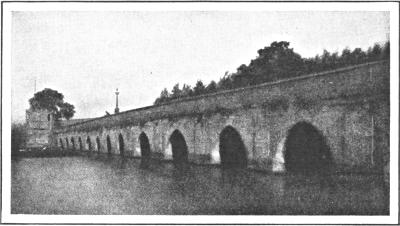
CLOPTON BRIDGE, STRATFORD
All those places, in themselves interesting, are associated with the Shakespeare Story, and a view of them gradually imparts to the observer’s mind a sympathetic comprehension of the environment in which Shakespeare was born and reared. The face of the country has, of course, been changed since his time, because little villages, fine villas, fertile farms, spacious parks, and blooming meadows now exist where once there was a woodland called the Forest of Arden (the indubitable forest, memories of which colored Shakespeare’s fancy when he wrote “As You Like It”), extending for many miles northward and westward from a point near Stratford and along the river Avon. Some things survive, however, which can be seen much as the poet saw them more than 300 years ago.

THE MILL, GUY’S CLIFF NEAR WARWICK
The name is derived from Guy, Earl of Warwick, who once lived as a hermit, in a cave below the house, and was buried there
When Shakespeare saw Kenilworth Castle he did not, indeed, see it as it now is, a picturesque mass of ruins,—the wreck made by Cromwell’s soldiers about 1643-45,—but as a stately structure, at once a fortress and a palace. Warwick Castle, on the contrary, was the same imposing structure to him that it is to the observer of today. In the modern part of that castle now the visitor is shown a sumptuous collection of paintings, including Van Dyck’s famous equestrian portrait of King Charles I, and such suggestive relics as the helmet and the death-mask of Cromwell; but those things impress the mind much less than does the building itself. That Shakespeare entered the Castle is not known; but that he saw it cannot be doubted, for Cæsar’s Tower—one of the older parts of it—which dominates the region around Warwick now has been grandly conspicuous there for more than 400 years, and in the poet’s time it must have been familiar to all inhabitants of Warwickshire. Kenilworth, Coventry, and Warwick figure in some of his historical plays, and his particular knowledge of all the surroundings of Stratford, and, indeed, of the whole of central England, through which the Wars of the Roses raged, is manifested in those dramas. He had ample opportunity of acquiring that knowledge.
The first twenty-one or twenty-two years of his life were passed by him in his native town. The next twenty-seven years he passed in London, visiting Stratford once a year. In his closing years, from about 1613 to his death in 1616, he dwelt in Stratford, in his house called New Place, bought by him in 1597, where he died. The traveler who visits the Shakespeare Country, viewing it exclusively with reference to its associations with the poet, should bear in mind these divisions of time. The larger part of Shakespeare’s work was done in London. It is mostly as a youth, though a little as a veteran, that personally he is connected with Stratford.

THE RED HORSE HOTEL, STRATFORD-UPON-AVON

WASHINGTON IRVING PARLOR IN THE RED HORSE HOTEL
In the course of the drive from Warwick to Stratford (either way) the traveler passes Ganerslie Heath and Blacklow Hill, places said to be haunted. On Blacklow Hill the corrupt Piers Gaveston, Earl of Cornwall, unworthy favorite of that weak king, Edward II, was beheaded, June 20, 1312, by order of Guy, tenth Earl of Warwick, whom he had opposed and maligned, calling him “the Black Dog of Arden,” and some of the peasantry of the neighborhood entertain to this day an old superstitious notion that dismal bells have been heard to toll from that hill at midnight. The scene of Gaveston’s decapitation is marked by a monument. Another place of interest to be seen in the course of the drive is Guy’s Cliff, a secluded residence, beside the Avon, traditionally associated with an ancient, fabled Guy, Earl of Warwick, who, after performing prodigies of valor, retired to that place and lived and died a hermit. Camden, the antiquary, Shakespeare’s contemporary, whose “Britannia” (1586) he probably knew, thus happily describes it:
“There have ye a shady little wood, cleere and cristall springs, mossy bottomes and caves, medowes alwaies fresh and greene, the river rumbling here and there among the stones with his streame making a mild noise and gentle whispering, and besides all this, solitary and still quietnesse, things most grateful to the Muses.”

CHARLECOTE HOUSE
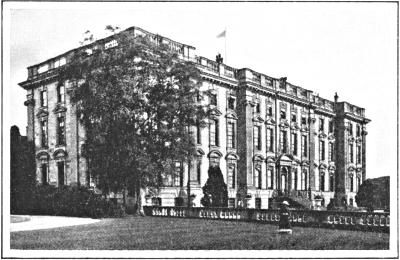
STONELEIGH ABBEY
This fine mansion, the seat of Lord Leigh, was erected in the eighteenth century, and occupies the site of a Cistercian Abbey, of which a gateway still remains
Those quaint words convey a just impression of the beauty of the Shakespeare Country. Its physical aspects are charming; its inhabitants and its products are characteristic; its historic associations are diversified and impressive. It is entirely worth seeing for its own sake, and it richly rewards the visitor who explores it in a sympathetic spirit and a leisurely way. But the great glory of Warwickshire consists in the fact that it was the birthplace of Shakespeare; the scene of all his youthful experience, his education, his courtship of Anne Hathaway (whose dwelling yet remains), his marriage, the birth of his three children, his death, and his burial.

THE TOWN HALL AND THE SHAKESPEARE HOTEL, STRATFORD-UPON-AVON

A ROOM IN THE OLD GRAMMAR SCHOOL, AT STRATFORD-UPON-AVON
I could never forget the emotion with which my mind was thrilled when first I took the drive from Warwick to Stratford (1877), and alighted at the old Red Horse Hotel. The day had been one of exceptional beauty. The long twilight had faded, and the stars were shining when that night, for the first time, I stood at the door of the birthplace of Shakespeare, and looked on its quaint casements and gables, its antique porch, and the massive timbers that cross its front. I conjure up the vision now, as I saw it then. I stand there for a long while, and feel that I shall remember these sights forever. Then, with lingering steps, I turn away, and, passing through a narrow, crooked lane, I walk in the High Street, and note at the end of the prospect the illuminated clock in a dark church-tower. A few chance-directed steps bring me to what was New Place once, where Shakespeare died, and there again I pause and long remain in meditation, gazing into the inclosed garden, where, under screens of wire, are fragments of mortar and stone. These—although I do not know it—are the remains of the foundations of Shakespeare’s house. The night wanes, but still I walk in Stratford streets, and by and by I am standing on the bridge that spans the Avon, and looking down at the thick-clustered stars reflected in the dark and silent stream. At last, under the roof of the Red Horse, I sink into a troubled slumber, from which soon a strain of celestial music, strong, sweet, jubilant, and splendid, awakens me in an instant, and I start up in bed,—to find that all around me is as still as death; and then, drowsily, far off, the bell strikes three, in that weird, grim, lonesome church-tower which I have just seen.

NEW PLACE GARDENS STRATFORD-UPON-AVON
Where Shakespeare’s house stood
Many times since that first night at Stratford I have rested in the old Red Horse, and nowhere, in a large experience of travel, have I found a more homelike abode. It is a storied dwelling, too; for it was an inn when Shakespeare lived. It is believed to have been known to those old poets Michael Drayton and Ben Jonson; Betterton is said to have lodged in it when he visited Stratford, to glean information about the great dramatist of whose chief characters his age esteemed him the supremely best interpreter; Garrick knew the house when he was in Stratford in 1769 to conduct the Shakespeare Jubilee; and in later years it has harbored scores of renowned persons from every part of the world. Washington Irving, revered as the father of American literature, was a lodger there in 1817, and wrote about it in his companionable “Sketch Book,” and the parlor that he then occupied has ever since borne his name and been embellished with picture and relic commemorative of his visit. The pilgrim loses much benefit and pleasure by carelessly speeding through the Shakespeare Country, as many excursionists do. It is far better to repose in the Red Horse, or some other cozy retreat, and spend many days in rambling about the neighborhood. To the lover of the works of Shakespeare the experience is one of the most profitable that life affords.
NEW PLACE, STRATFORD-UPON-AVON
The last residence of Shakespeare. Only the site now remains

From an Old Drawing
In driving from Warwick to Stratford the traveler obtains a distant glimpse of Stoneleigh Abbey, one of the fine baronial homes of England, the residence of Lord Leigh, and at a certain stile, near Charlecote House, the carriage is halted, so that the spacious park of Charlecote can be crossed on foot by a passenger who may wish to see the place where, as legend has long affirmed, Shakespeare killed the deer of Sir Thomas Lucy, thereby incurring enmity and punishment. The story lacks proof. No deer were kept by Sir Thomas at Charlecote,—though now they are numerous there,—but they were kept by him at Fullbrook, a park that he owned, not very far from Charlecote, and it is not impossible that Shakespeare and his comrades, in the wildness of frolicsome youth, did poach upon his preserves. Tradition, in all old English country places, has, when tested, often been found entirely worthy of credence.
The Stratford of the sixteenth century, though then nearly 300 years old, was merely a village. The houses were chiefly of the one-story kind, made of timber. The inhabitants were in number about 1,400: indeed, the whole population of England was not so numerous as that of London is now. If Shakespeare could revisit his old haunts, though he would see the same green, rose-decked, and poppy-spangled countryside that once he knew, and hear the ripple of the Avon softly flowing between its grassy banks, he would miss many objects once familiar to him, and he would be conscious of much change,—in many ways for the better. Yet there are the paths in which he often trod; there is the school in which he was taught; there is the garden of the mansion that he once owned, and in which he died and there is the ancient church that enshrines his tomb.

THOMAS NASH’S HOUSE, STRATFORD-UPON-AVON
Nash was the husband of Shakespeare’s only granddaughter. The house stands next to New Place
The Birthplace, as it is now designated, is a two-story cottage made of timber and plaster, with dormer windows in its sloping, attic roof. It was originally a finer house than most of its neighbors. Its age is unknown. John Shakespeare, William’s father, bought it in 1556 and occupied it till his death, in 1601, when it became William’s property by inheritance. By him it was bequeathed to his sister, Joan, Mrs. William Hart. It has passed through many ownerships and has been materially changed; but parts of it remain as originally they were, particularly the room on the ground floor, in which there is a large fireplace, with seats in the brick chimney jambs, and also the one immediately above it, the best room in the house, in which, according to ancient tradition, the poet was born. In that room there is a chair, of the sixteenth century.

ROOM IN WHICH, ACCORDING TO TRADITION, SHAKESPEARE WAS BORN
The original window remains, a threefold casement, containing sixty panes of glass, on which many visitors have scratched their names with diamonds. No writing, on window or walls, is permitted now; but in earlier times it was allowed, and it was customary. Sir Walter Scott scratched his name on the window,—“W. Scott.” Byron wrote on the ceiling, which is low, as also did Thackeray. Byron’s name has disappeared. Dickens wrote on one of the walls. The names of many actors, including those of Edmund Kean and Edwin Booth, are inscribed on the chimney-jamb at the right of the fireplace. Booth was specially requested to write his name there, “high up.” That jamb is called “The Actors’ Pillar.”
The Birthplace was purchased for the nation in 1847—the American museum and circus manager P. T. Barnum having alarmed England by proposing to buy and remove it to America. New Place and Anne Hathaway’s Cottage, at Shottery, about a mile west of Stratford, have since then been purchased, and those properties are now administered as a trust for the public.
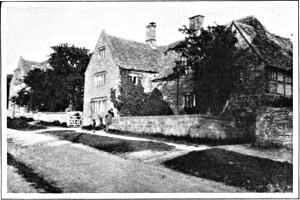
THE HOME OF SHAKESPEARE’S MOTHER
The Mary Arden Cottage at Wilmcote, a little village near Stratford
New Place, the finest mansion in the town when Shakespeare bought it, was destroyed in 1759 by order of Rev. Thomas Gastrell, its owner at that time, who had been annoyed by many visitors, thronging to see his house and to sit under a mulberry tree in his garden, believed to have been planted and reared by Shakespeare. The tree was cut down by Mr. Gastrell; but a reputed “grandson” of it is growing there now. Nothing remains of the building except its foundation, long buried, but later exhumed, and now carefully preserved. The house was situated directly opposite the Guild Chapel, a relic of the thirteenth century, and one of the most venerable and pictorial of the towered churches of England. Shakespeare hired two sittings in that church, and when he lived in New Place he must have seen it almost continually. Next to the church is the Grammar School, established in 1482, which there is every reason to believe he attended in his boyhood. The building has been tastefully “restored” to its original condition: the schoolroom has not been altered.
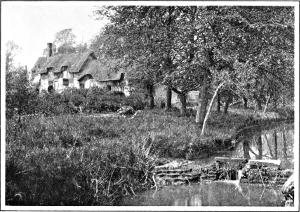
ANNE HATHAWAY’S COTTAGE, SHOTTERY: FROM THE BROOK.
The Hathaway Cottage, to which the flower-bordered path is an ancient “right of way,” through gardens and meadows that Shakespeare must often have traversed, is an exceptionally fine specimen of the timber-crossed, thatch-roofed dwelling of the Tudor period. It stands in a large garden, is shaded by tall trees, and is prettily clad with woodbine, ivy, wild roses, and maiden’s blush. In one of the upper chambers a large, antique, carved four-post bedstead is shown, as having been used by Anne Hathaway. It is possible that William and Anne lived in that cottage immediately after their marriage, which occurred in 1582. He was eighteen, she was twenty-six. The bond (a document required in those days to obtain authorization of wedlock) is preserved and may be inspected in the Edgar Tower at Worcester, where I saw it in 1889. The actual record of their marriage is supposed to have perished in a fire (before 1600) which, consuming the church of Ludington, a village near Shottery, destroyed the registers of that parish.
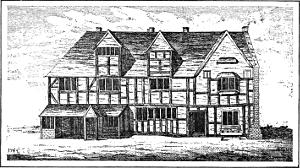
From an Old Drawing
THE HOUSE IN WHICH SHAKESPEARE WAS BORN
At Stratford-upon-Avon

From an Old Drawing
THE JUBILEE BOOTH
At Stratford-upon-Avon
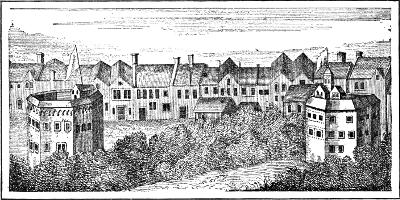
From an Old Drawing
THE BEAR GARDEN AND THE GLOBE THEATER IN LONDON
The first named at the extreme left of the picture and the second at the extreme right
Shakespeare was poor, when (1585) he went to London, and I venture the conjecture that when he returned to Stratford he found his wife and children dwelling at either the Hathaway Cottage or the home of his friends Hamnet and Judith Sadler, after whom his latest born children, Hamnet and Judith, twins, were named. The Hathaway Cottage seems vitally associated with him, as is still another old timbered house, the home of his mother, Mary Arden, which may be seen on the outskirts of the village of Wilmcote, situated about four miles northwest of Stratford,—an easy, pleasant walk.

THE AVENUE TO THE CHURCH
Stratford-upon-Avon
Indeed, there is scarce an end to the variety of pleasant walks feasible in the Shakespeare Country, and I have found it specially suggestive of agreeable thoughts and feelings to stroll in many directions and for many miles around Stratford, and to fancy the presence of Shakespeare himself rambling, as probably his custom was, over all the countryside. How else could he have gained the minute knowledge that is manifested in his plays of Warwickshire names, localities, characters, customs, and the many peculiarities of foliage and flower that distinguish the Warwickshire clime? The “palm” that Orlando finds in the Forest of Arden in “As You Like It” is not an oriental palm, but a tree so named that grows now and has always grown on the banks of the Avon. “Christopher Sly, of Burton Heath” and “Marian Hacket, the fat ale-wife of Wincot” are types of Warwickshire peasantry, which no doubt Shakespeare saw. Barton Heath and Wincot are places not distant from his home.
To trace the course of Shakespeare from his birth to his death, is to gain knowledge and wisdom. It is wisely written by the poet Tennyson that “Things seen are mightier than things heard.”
| SHAKESPEARE’S ENGLAND | By William Winter |
| A most interesting and beautifully illustrated book. | |
| HIGHWAYS AND BYWAYS IN SHAKESPEARE’S COUNTRY | By W. H. Hutton |
| With numerous illustrations by Edmund H. New. | |
| THE WARWICKSHIRE AVON | By A. T. Quiller-Couch |
| Illustrated by Alfred Parsons. | |
| SHAKESPEARE’S TOWN AND TIME | By H. S. Ward and C. W. B. Ward |
| SHAKESPEARE’S LONDON | By T. F. Ordish |
| SHAKESPEARE’S LOVE STORY | By A. B. McMahon |
| RELIQUES OF STRATFORD-UPON-AVON | Compiled by A. E. Way |
| SEEN AND UNSEEN AT STRATFORD-UPON-AVON | By W. D. Howells |
| SHAKESPEARE AND STRATFORD | By H. C. Shelley |
⁂ Information concerning the above books may be had on application to the Editor of the Mentor.
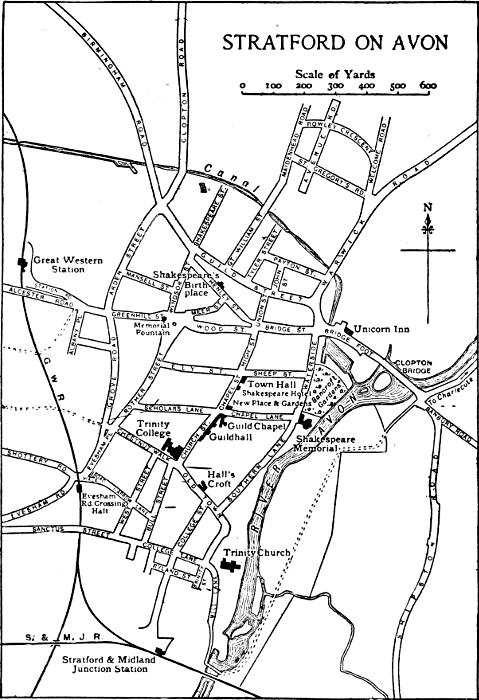
STRATFORD ON AVON
Reproduced from W. H. Hutton’s “Highways and Byways in Shakespeare’s Country.” Published by The MacMillan Co.
The saying goes in theatrical circles that Shakespeare “doesn’t pay.” And yet the editions of Shakespeare outnumber those of any other book except the Bible, and many new editions appear each season. It seems then that though we read Shakespeare we do not go to see his plays performed. Apparently it pays a publisher to place Shakespeare on the shelf, but it does not pay a producer to place him on the stage.
I cannot accept this statement without qualification, for I have known years—not far back—when Shakespeare was a regular and profitable feature of the stage. My knowledge of Shakespeare on the stage began with Edwin Booth, Lawrence Barrett, Henry Irving, John McCullough, Salvini and the famous women, Modjeska, Ellen Terry, and others who were their associates in dramatic art. In recent years I have listened to Mantell, Mansfield, Sothern and Marlowe. I have seen some of these players many times in their favorite roles. I am sure that there are few modern plays compelling enough in interest to draw one to see them more than a half dozen times. But it was a common thing a few years ago to hear people say that they had seen Booth or Irving a dozen times in a single role.
In those days Shakespeare was played not only with profit by the great stars, but by stock-companies as well. Augustin Daly, during several successive, and successful, years produced the Comedies with his strong company. And these were not gala performances. They were steady going attractions. In reckoning stage successes today, we consider a run of 100 nights a matter for celebration. In his time, Edwin Booth played “Hamlet” for 100 nights in succession in one New York theater, and Irving played “The Merchant of Venice” for the greater part of a whole season. Runs of a single play of Shakespeare for several weeks were not uncommon.
But still they say today that Shakespeare on the stage does not pay. That means, of course, that we folks of today do not go to hear Shakespeare. Why don’t we go? We did when Booth, Barrett, Irving and Salvini played. And if Henry Irving should bring us today a production of The Merchant of Venice such as he made familiar to the theater-goers of his time, Shakespeare would pay again. If we do not go to hear Shakespeare played it is because we want Shakespeare only when it is produced and played as well as Shakespeare reads. When a man of genius and imagination gives us Shakespeare as “big as we find him in his plays,” we will surely go to hear him on the stage today—as our parents did in former days, and as we did yesterday.

W. D. Moffat
Editor
The Mentor Association
ESTABLISHED FOR THE DEVELOPMENT OF A POPULAR INTEREST IN ART, LITERATURE, SCIENCE, HISTORY, NATURE, AND TRAVEL
CONTRIBUTORS—PROF. JOHN C. VAN DYKE, HAMILTON W. MABIE, PROF. ALBERT BUSHNELL HART, REAR ADMIRAL ROBERT E. PEARY, WILLIAM T. HORNADAY, DWIGHT L. ELMENDORF, HENRY T. FINCK, WILLIAM WINTER, ESTHER SINGLETON, PROF. G. W. BOTSFORD, IDA M. TARBELL, GUSTAV KOBBÉ, DEAN C. WORCESTER, JOHN K. MUMFORD, W. J. HOLLAND, LORADO TAFT, KENYON COX, E. H. FORBUSH, H. E. KREHBIEL, SAMUEL ISHAM, BURGES JOHNSON, STEPHEN BONSAL, JAMES HUNEKER, W. J. HENDERSON, AND OTHERS.
The purpose of The Mentor Association is to give its members, in an interesting and attractive way, the information in various fields of knowledge which everybody wants to have. The information is imparted by interesting reading matter, prepared under the direction of leading authorities, and by beautiful pictures, produced by the most highly perfected modern processes.
THE MENTOR IS PUBLISHED TWICE A MONTH
BY THE MENTOR ASSOCIATION, INC., AT 52 EAST NINETEENTH STREET, NEW YORK, N. Y. SUBSCRIPTION, THREE DOLLARS A YEAR. FOREIGN POSTAGE 75 CENTS EXTRA. CANADIAN POSTAGE 50 CENTS EXTRA. SINGLE COPIES FIFTEEN CENTS. PRESIDENT, THOMAS H. BECK; VICE-PRESIDENT, WALTER P. TEN EYCK; SECRETARY, W. D. MOFFAT; TREASURER, ROBERT M. DONALDSON; ASST. TREASURER AND ASST. SECRETARY, J. S. CAMPBELL
IMPORTANT
Members who desire to procure complete Mentor Libraries or special sets of The Mentor devoted to their favorite subjects will be interested in the announcement on the back cover of this issue. We suggest that you send for your sets at once.
NUMBERS TO FOLLOW
June 15. HISTORIC GARDENS OF NEW ENGLAND. By Mary H. Northend.
July 1. THE WEATHER. By C. F. Talman, of the United States Weather Bureau.
THE MENTOR ASSOCIATION, Inc.
52 EAST 19th STREET, NEW YORK, N. Y.
THE MENTOR
Do you prefer art, literature, travel, nature, architecture and furniture, biography, or music? A great many members have asked us “Can I procure all the Mentors on any one subject—art, for instance?” Yes, you may. And for your convenience we have grouped the subjects below:
1. GREAT HEROES AND HEROINES OF HISTORY
2. NEXT DOOR NEIGHBORS
3. HEROIC ACHIEVEMENTS
4. ART IN THE HOME
5. MUSICAL MOMENTS
6. BEAUTIES OF ARCHITECTURE
7. PERSONALLY CONDUCTED
8. GREAT RIVERS
9. GREAT ART GALLERIES
10. MASTERS AND MASTERPIECES IN ART
11. UNDER OPEN SKY
12. ART IN AMERICA
13. LITTLE VISITS TO EUROPEAN CITIES
14. PLEASANT TALKS ON BOOKS AND WRITERS
15. PERSONALITY IN ART
16. AMERICA IN STORY AND PICTURE
Select your favorite subjects: Let us know which sets you want. It is not necessary to send any money now. Merely indicate by number the sets that you desire. They will be sent to you at once. You may pay later. Act immediately. You will be glad to have your favorite Mentors.
SEND ALL ORDERS TO
The Mentor Association
52 EAST NINETEENTH STREET NEW YORK, N. Y.
MAKE THE SPARE
MOMENT COUNT
